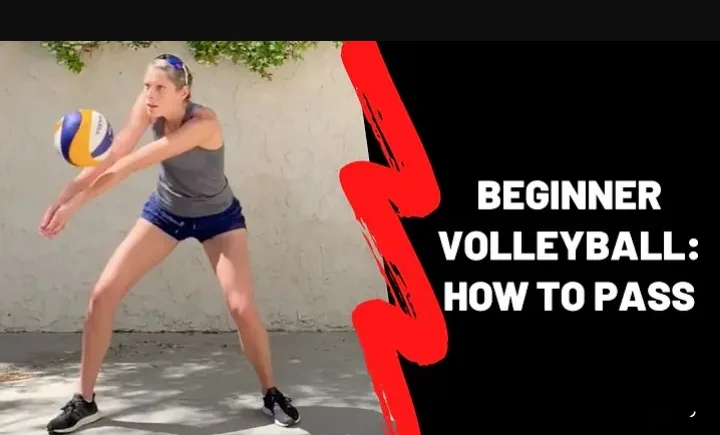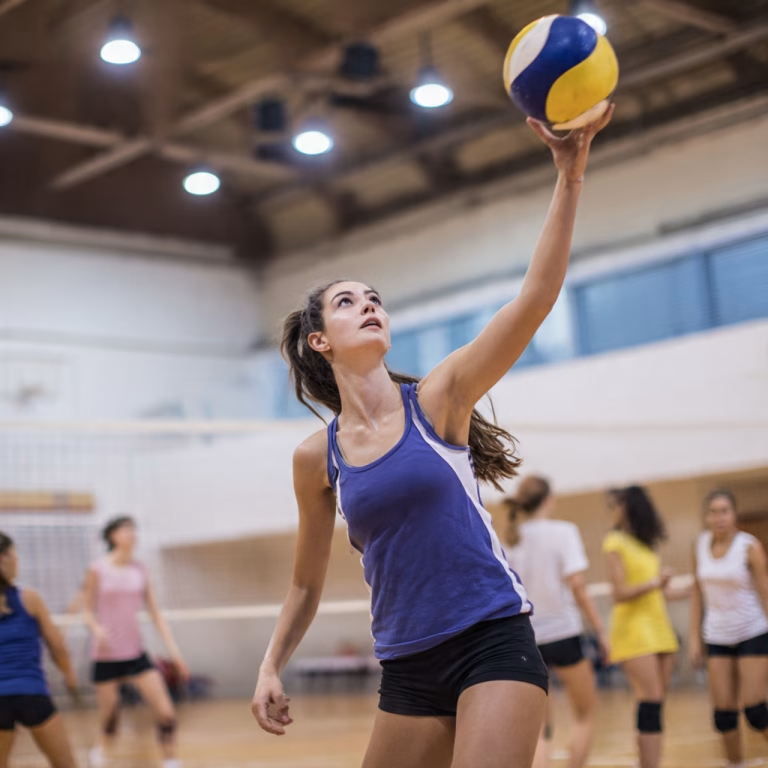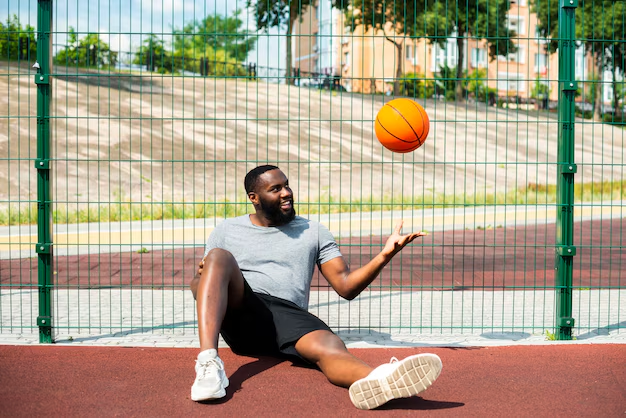Here, we want to look at volleyball bumping drills for beginners. Volleyball bumping, also known as passing, is a fundamental skill that you need to know, whether you are a beginner or a professional.
This drill will equip you with the necessary skills and knowledge you need. Remember, volleyball passing drills and player interaction are key to success for beginners and professionals.
You can individually practice these drills at your own pace using a wall or a basketball backboard. It’s good to do a workout together with a partner or three people. To develop good volleyball passing skills, you need to read this article to the end and practice it.
Let’s begin with the types of volleyball passes and their various techniques.
Types of volleyball bumping (Passes)
Passing in volleyball sets up the rest of the plays, making it very important for you to master and understand the different types of bumping (passing) in volleyball. Here are the seven types of volleyball passes, each with its own unique purpose and technique.
1. Normal Pass:
A normal pass, also known as a forearm pass or standard form, is one of the types of pass in volleyball that involves extending your arms with your wrists locked together and your shoulders shrugged to create a stable platform.
Usage: The most common pass is used for balls above waist height. Reliable and accurate, making up about 70% of all passes.
2. Absorb Pass:
This is another type of volleyball pass that is similar to a normal pass but with added absorption by bending knees and leaning backward.
Usage: Used for hard-driven balls to prevent them from going back over the net. Focuses on keeping the ball in play rather than precise placement.
3. Deep Pass:
This volleyball passes involves a large arm swing to generate power, often mid-run or off balance.
Usage: For passing balls deep in the court when off balance. Ensures the ball reaches teammates or goes over the net.
4. Diving Pass:
This a types of pass made while diving, using the same motion as a normal pass.
Usage: For difficult balls that require extending reach. Ensures continued play by sliding and catching the ball.
5. Pancake:
Technique: Place your hand flat on the ground under the ball to pass it upwards.
Usage: Last-ditch effort to save the ball from touching the floor. Commonly paired with a diving motion.
6. Overhand Pass:
Technique: Use the setting position to pass the ball.
Usage: For high balls or float serves. Provides controlled passing and reduces disorientation from drifting serves.
7. Tomahawk
Technique: Clasp hands above the head like holding a tomahawk and use the bottom of the hands to pass.
Usage: quick reaction to balls flying at your face, often used in beach volleyball. It helps handle balls from imperfect angles.
Key Elements of Passing
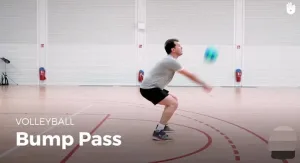
Regardless of the type, all passes share common elements:
- Using Forearms and Hands: Provides control and allows aiming.
- Moving Through the Ball: This ensures the ball goes forward.
- Aiming with Shoulders: Determines the direction of the pass.
- Moving from low to high: helps put the ball high enough for teammates to play.
Do you need more information about volleyball pass types and techniques? Read more about it on the topic: 7 types of passes in volleyball
15 Volleyball Bumping Drills for Beginners
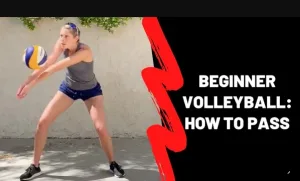
As a beginner, you need to master bumping because it is crucial, as it sets the foundation for all other aspects of the game.
These volleyball bumping drills are designed to enhance your skills in serving, passing, hitting, setting, and more.
This Bumping Drills for Beginners are perfect for getting kids and novice players enthusiastic about volleyball.
Volleyball bumping drills for beginners are:
- Energy Check Drill
- Down Ball Hitting Drill
- Toss Up Setting Drill
- Fizzles Setting Drill
- Four Sets Drill
- Low-Catch Passing Drill
- Volleyball Burpee Passing Drill
- Deliver and Pop-Serve Drill
- 10 to Kill Ball Control Drill
- Popcorn Ball Control Drill
- Big Kernel, Little Kernel Ball Control Drill
- Five-Second Rule Ball Control Drill
- Muscle memory throws a drill
- Serve Receive Wave Drill
- Flip-Flop Passing Drill
Let’s look at it in detail.
1. The Energy Check Drill
This volleyball bump drill is designed to keep the team’s energy high and maintain focus and enthusiasm during the practice. The Energy Check Drill is a quick and fun way to boost morale.
To do it, hold a volleyball between your knees, clap out a rhythm on your thighs and hands, and finish with a loud cheer of “volleyball!” This drill helps energize the team and prepare them for more focused practice sessions.
2. Down Ball Hitting Drill
This drill is designed to warm up players’ hitting hands, which is essential for effective bumping.
How to do down-ball volleyball bumping drills:
To carry out these bumping drills, you need to position the ball in front of your hitting shoulder and strike it against the floor using your entire hitting hand. This exercise strengthens the hitting hand and also helps players understand the impact and control needed for effective bumping.
3. Toss Up Setting Drill
To improve ball and body positioning while setting, the toss-up setting drill is invaluable.
How to do toss up volleyball pumping drills:
Stand with one foot slightly ahead of the other, toss the ball above your heads, and catch it with your fingers spread wide. With this drill, you’re going to master proper ball placement and control, which is crucial for successful bumping.
4. Fizzle Setting Drill
The Fizzles Setting Drill helps players get a good feel for the ball in their hands. Players toss the ball above their heads and then set a low ball for themselves for three repetitions. This drill emphasizes control and precision, key components of effective bumping.
5. Four-Set Drill
This volleyball bumping drills for beginners focuses on low-to-high ball control.
How to:
Start with setting a low ball for yourself with three repetitions, and finish with one high set. The Four Sets Drill improves consistency and accuracy in ball handling, which are essential for bumping.
6. Low-Catch Passing Drill
Handling the ball in a low-body position is crucial for effective bumping. In this drill, players toss the ball high into the air, let it bounce once, and catch it just before it hits the floor a second time while maintaining a low base. This exercise helps players become comfortable with low passes and improves their reaction time.
7. Volleyball Burpee Passing Drill
This drill is an extension of the Low Catch Passing Drill; it teaches players how to move with the ball. Start with catching the ball in a low position, tap it on the floor to the right, middle, and left of your body, then pop up to a standing position. This drill enhances agility and coordination, which are vital for successful bumping.
8. Deliver and Pop-Serve Drill: volleyball bumping drills for beginners
Getting comfortable with the overhand serve toss is essential for beginners. In this drill, players “deliver” the ball at the top of their reach, then drop it to the floor. Next, they add a small toss at the delivery point and contact the ball with a “pop” from their serving hand. This drill builds the foundation for strong serving and passing skills.
9.10 to Kill Ball Control Drill
This cooperative drill emphasizes ball control and teamwork. In a 6 vs. 6 setup, teams work together to keep the ball in play. Once the ball has crossed the net 10 times, either side can attempt a kill to win a big point. The first team to score five big points wins. This drill enhances team coordination and control, key aspects of bumping.
10. Popcorn Ball Control Drill
The Popcorn Ball Control Drill helps you become comfortable with ball control using long and strong arms.
How to:
Bounce the volleyball from arm to arm using a single bounce, then progress to a double bounce. This drill improves hand-eye coordination and control, which are critical for effective bumping.
Read more:
- How to Spike Volleyball with Power
- Discover Home Volleyball Training Equipment
- Basic Skills in Volleyball
- 7 Volleyball Conditioning Drills: A Comprehensive Guide for Players
11. Big Kernel, Little Kernel Ball Control Drill
This volleyball bumping drill is a variation of the popcorn drill. Players practice control by bouncing a ball from arm to arm using a little bounce, big bounce pattern. It enhances precision and control, essential skills for bumping.
12. Five-Second Rule Ball Control Drill
This challenging drill requires players to touch the floor on alternating high bounces. It builds agility and quick reflexes, which are necessary for successful bumping.
13. Muscle Memory Throws Drill
In this partner drill, players practice four muscle memory throws that help develop proper hitting and serving techniques. This drill reinforces the correct form and technique needed for effective bumping.
14. Serve Receive Wave Drill
This drill focuses on service reception. Servers send balls across the net, and opposing passers return the ball to a target player. After 10 good passes, servers and passers swap positions, and the drill repeats for another 10 points. This drill improves passing accuracy and consistency, which are essential for bumping.
15. Flip-Flop Passing Drill
In this drill, two players take turns tossing balls to a passer between them. After passing the ball to the first tosser, the passer rotates 180° to receive and return the ball to the second tosser. This drill enhances agility and passing accuracy, crucial for effective bumping.
How to Pass Volleyball Correctly
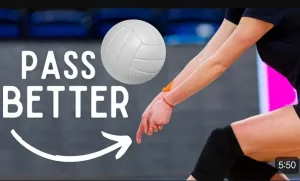
Passing the ball effectively is crucial in volleyball, forming the foundation for setting up attacks and scoring points.
To pass volleyball correctly when executing an overhead pass, start with knees slightly bent and hands positioned with fingers spread, forming a triangle with your thumbs and index fingers.
Meet the ball with open palms, bend your legs to absorb the impact, and transfer your body’s center of gravity to your toes. Extend your knees and elbows, straightening your body to push the ball upwards. For a behind-the-back pass, bend your body backward, extend your arms over your head, and use your momentum to guide the ball behind you.
For a forearm pass, extend your arms forward with locked elbows and bend your knees slightly. Position one foot slightly ahead of the other for stability. Make a fist with one hand and cover it with the other, ensuring your thumbs are parallel and close together.
Allow the ball to contact your lower forearms while keeping your arms straight and steady. Shift your body’s center of gravity to your front foot, lean forward slightly, and push through with your legs to guide the ball.
Always maintain a low stance, use quick, small steps for positioning, and follow through with your arms and body after contact for accurate passes.
Practicing these techniques regularly will enhance your ball control and overall gameplay.

